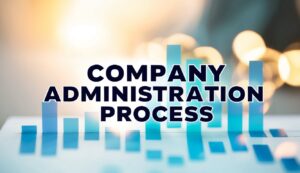Understanding the Role of an Administrator in UK Insolvency Proceedings: Key Responsibilities and Legal Powers
What Is an Administrator in UK Insolvency?
An administrator plays a crucial role in UK insolvency proceedings, acting as a licensed insolvency practitioner to manage and potentially rescue struggling companies. They have significant powers and responsibilities under UK law.
Definition and Appointment of an Administrator
An administrator is a licensed insolvency practitioner appointed to manage a company’s affairs during insolvency proceedings. Their primary goal is to rescue the company as a going concern or achieve a better outcome for creditors than immediate liquidation.
Administrators can be appointed by:
- The company directors
- A floating charge holder (usually a bank)
- The court
Once appointed, the administrator takes control of the company’s assets and business operations. They act as the company’s agent, with broad powers to manage its affairs, business, and property.
Legal Framework Governing Administrators in the UK
The Insolvency Act 1986 and the Enterprise Act 2002 provide the legal foundation for administration in the UK. These laws outline the administrator’s duties, powers, and responsibilities.
Key aspects of the legal framework include:
- The creation of a moratorium to protect the company from creditor actions
- The administrator’s duty to act in the best interests of all creditors
- The requirement to submit proposals for achieving the purpose of administration
- The power to continue trading the business or sell assets as necessary
You should be aware that administrators must follow strict legal procedures and timelines throughout the administration process. Their actions are subject to scrutiny by creditors and the court to ensure compliance with the law and fair treatment of all parties involved.
Free Consultation – advice@andersonbrookes.co.uk or call on 0800 1804 933 our freephone number (including from mobiles).
Duties and Responsibilities of an Administrator
Administrators play a crucial role in UK insolvency proceedings, tasked with managing the affairs of a company in financial distress. Their primary aim is to rescue the business or achieve the best outcome for creditors.
Acting in the Interests of Creditors
As an administrator, you must prioritise the interests of creditors as a whole. This means making decisions that maximise the chances of repayment for all parties involved. You’re required to:
- Assess the company’s financial position thoroughly
- Communicate regularly with creditors about the administration process
- Distribute funds fairly according to the legal order of priority
Your actions should be transparent and justifiable. You must maintain detailed records of all decisions and transactions to ensure accountability.
Managing Company Affairs During Administration
During the administration period, you take control of the company’s operations. Your responsibilities include:
- Safeguarding company assets
- Continuing day-to-day business activities where beneficial
- Reviewing and, if necessary, terminating contracts
- Dealing with employee matters, including potential redundancies
You have the authority to hire specialists or consultants to assist in managing specific aspects of the business. It’s crucial to balance cost-saving measures with maintaining the company’s value as a going concern.
Developing and Implementing a Rescue Plan
A key duty is to formulate a strategy for the company’s future. This involves:
- Analysing the business to identify viable parts
- Exploring restructuring options
- Negotiating with potential buyers if a sale is appropriate
You must present your proposals to creditors within eight weeks of appointment. The plan should outline how you intend to achieve the purpose of administration. This might involve:
- Rescuing the company as a going concern
- Achieving a better result for creditors than immediate liquidation
- Realising property to make distributions to secured or preferential creditors
Your plan should be realistic and achievable, based on thorough analysis of the company’s situation.
Powers Granted to an Administrator
An administrator in UK insolvency proceedings is vested with extensive authority to manage the affairs of a company in administration. These powers enable the administrator to effectively pursue the objectives of the administration process.
Authority to Manage and Dispose of Company Assets
As an administrator, you have broad powers to manage the company’s affairs, business, and property. You act as the company’s agent and can do anything necessary or expedient for its management. This includes the authority to dispose of assets.
You can sell company property, enter into or terminate contracts, and make decisions about ongoing operations. Your powers extend to accessing and controlling all company assets, including bank accounts and intellectual property.
It’s crucial to exercise these powers responsibly and in line with the objectives of the administration. You must always act in the best interests of the creditors as a whole.
Ability to Make Contracts and Legal Decisions on Behalf of the Company
As an administrator, you have the power to enter into contracts on behalf of the company. This includes negotiating new agreements, modifying existing ones, or terminating contracts that are no longer beneficial.
You can initiate or defend legal proceedings in the company’s name. This authority allows you to pursue debts owed to the company or defend against claims made against it.
You also have the power to borrow money on behalf of the company, using its assets as security if necessary. This can be crucial for maintaining operations or funding the administration process.
Interaction with Directors and Employees During Administration
When you’re appointed as an administrator, the powers of the company’s directors are suspended. You take over the management of the company, though directors remain in office.
You have the authority to remove or appoint directors if it’s in the best interests of the administration. You can also require directors to provide information about the company’s affairs.
Regarding employees, you have the power to continue their employment or make redundancies as necessary. You must follow proper employment law procedures when making these decisions.
You can delegate certain powers to other individuals, but you remain responsible for the administration process. It’s essential to maintain clear communication with all stakeholders throughout the administration.
The Administration Process: An Administrator’s Role
The administration process involves several key stages where the administrator plays a crucial role in managing the insolvent company’s affairs. Their responsibilities encompass initiating proceedings, assessing finances, and keeping stakeholders informed.
Initiating the Administration Procedure
To begin administration, you must file the necessary documents with the court. As an administrator, you’ll need to submit a proposal outlining your intended approach. This proposal should detail how you plan to achieve the administration’s objectives, which typically include rescuing the company or getting a better result for creditors than immediate liquidation.
You’ll also need to notify relevant parties, including creditors, employees, and shareholders. This notification must occur within seven days of your appointment. It’s your duty to take control of the company’s assets and manage its day-to-day operations during this period.
Conducting an Assessment of the Company’s Financial Position
Once appointed, you’ll need to conduct a thorough review of the company’s financial situation. This involves:
- Examining financial records
- Valuing assets
- Identifying potential sources of revenue
- Assessing outstanding debts and liabilities
Your goal is to develop a clear picture of the company’s viability. You’ll need to determine if there’s a realistic chance of rescuing the business as a going concern or if alternative strategies, such as selling assets, would better serve creditors’ interests.
This assessment forms the basis of your strategy moving forward. You may decide to continue trading if it’s in the creditors’ best interests, or you might choose to wind down operations gradually.
Reporting to Creditors and the Court
Communication is a key part of your role as an administrator. You must prepare and distribute regular reports to creditors and the court. These reports should include:
- Updates on the company’s trading position
- Progress towards achieving administration objectives
- Details of any significant decisions or actions taken
Within eight weeks of your appointment, you must hold a creditors’ meeting. Here, you’ll present your proposals for achieving the administration’s purpose. Creditors have the opportunity to vote on these proposals.
You’re also required to file progress reports with the court every six months. These reports provide a comprehensive overview of the administration’s progress and any major developments.
Legal Obligations and Ethical Considerations
Administrators in UK insolvency proceedings must adhere to strict legal and ethical standards. These requirements ensure the process remains fair, transparent, and in compliance with relevant laws and regulations.
Compliance with the Insolvency Act 1986 and Subsequent Amendments
The Insolvency Act 1986 forms the foundation of an administrator’s legal obligations. You must familiarise yourself with this Act and its amendments, particularly those introduced by the Enterprise Act 2002. These laws outline your powers, duties, and responsibilities as an administrator.
Key responsibilities include:
- Acting in the best interests of creditors
- Attempting to rescue the company as a going concern
- Achieving a better result for creditors than immediate liquidation
Failure to comply with these legal requirements can result in serious consequences, including removal from office and potential legal action. It’s crucial to stay up-to-date with any changes in legislation that may affect your role.
Maintaining Transparency and Fairness Throughout the Process
As an administrator, you have a duty to ensure transparency and fairness in all your actions. This involves:
- Regular communication with creditors, shareholders, and employees
- Providing clear and accurate information about the company’s financial situation
- Conducting thorough investigations into the company’s affairs
- Making impartial decisions based on factual evidence
You must also maintain detailed records of all decisions and actions taken during the administration process. These records may be scrutinised by creditors, the court, or regulatory bodies.
Avoiding Conflicts of Interest
Identifying and managing potential conflicts of interest is a critical ethical consideration for administrators. You must:
- Disclose any personal or professional relationships with the insolvent company or its directors
- Avoid accepting appointments where your independence may be questioned
- Refrain from purchasing assets from the insolvent company without proper disclosure and approval
If a conflict arises during the administration, you should seek independent advice and consider stepping down if necessary. Failure to manage conflicts of interest can undermine the integrity of the insolvency process and expose you to legal and professional risks.

Challenges Faced by Administrators
Administrators in UK insolvency proceedings encounter numerous obstacles as they work to rescue struggling companies or efficiently manage their closure. These challenges require a delicate balance of financial expertise, legal knowledge, and strategic decision-making.
Balancing the Interests of Various Stakeholders
Administrators must juggle the often conflicting priorities of different parties involved in the insolvency process. Creditors seek maximum repayment, while employees hope to retain their jobs. Shareholders may desire to salvage their investments, and customers might need ongoing support.
Balancing these diverse interests requires careful negotiation and clear communication. Administrators must make difficult decisions that may disappoint some stakeholders whilst benefiting others. You’ll find that transparency in decision-making and regular updates to all parties can help mitigate tension and maintain trust throughout the process.
Navigating Complex Financial and Legal Issues
The financial landscape of a distressed company can be intricate and challenging to untangle. Administrators must:
- Analyse complex financial records
- Identify assets and liabilities
- Assess potential recovery options
- Navigate contractual obligations
Legal considerations add another layer of complexity. You must ensure compliance with insolvency laws, employment regulations, and contractual obligations. This often involves:
- Dealing with ongoing litigation
- Negotiating with creditors
- Managing potential investigations into company affairs
Staying up-to-date with evolving legislation and case law is crucial for effective administration.
Ensuring Business Continuity or Efficient Wind-Down
Whether pursuing a rescue strategy or managing an orderly wind-down, administrators face significant operational challenges. In rescue scenarios, you must:
- Secure essential funding to maintain operations
- Retain key staff and suppliers
- Implement cost-cutting measures
- Explore restructuring options
For wind-downs, efficient asset realisation and orderly closure are paramount. This involves:
- Valuing and selling assets
- Managing redundancies
- Dealing with landlords and lease terminations
- Ensuring proper record-keeping for future inquiries
Time pressure adds to these challenges, as swift action is often necessary to preserve value and minimise costs.
Recent Developments
UK insolvency law has seen significant changes in recent years. These developments have affected how administrators carry out their roles and responsibilities in complex cases.
The Corporate Insolvency and Governance Act 2020 introduced new restructuring tools. As an administrator, you must now consider options like the new moratorium procedure when assessing rescue possibilities for struggling companies.
Changes to pre-pack administration rules in 2021 require additional scrutiny for connected party sales. You’re now obliged to obtain an independent opinion or creditor approval in these scenarios, adding extra steps to the process.

How Anderson Brookes Can Assist
Anderson Brookes offers comprehensive services to guide companies through insolvency proceedings. Our experienced team provides expert advice and hands-on support throughout the administration process.
Expertise in Acting as Administrators for Distressed Companies
Anderson Brookes has extensive experience serving as administrators for struggling businesses. Our licensed insolvency practitioners take control of distressed companies to manage affairs and explore restructuring options. We assess the company’s financial position, liaise with creditors, and develop strategies to maximise returns.
Administrators work to:
- Stabilise operations and cash flow
- Review contracts and negotiate with suppliers
- Identify and realise valuable assets
- Explore options for business rescue or sale
Our goal is to achieve the best possible outcome, whether through restructuring or orderly wind-down. We support clients with:
- Preparing necessary documentation
- Communicating with creditors and stakeholders
- Developing restructuring plans
- Overseeing day-to-day operations during administration
- Negotiating with potential buyers if applicable
Our hands-on approach ensures you understand each stage of the process. Our team manages administrative tasks so you can focus on core business matters.
Free Initial Consultation to Discuss Your Options
Anderson Brookes provides a no-obligation initial consultation to review your situation. In this meeting, their advisers will:
- Assess your company’s financial position
- Explain available insolvency procedures
- Outline potential outcomes of administration
- Answer your questions about the process
This allows you to make an informed decision about how to proceed. There’s no pressure to engage their services after the consultation. It’s an opportunity to gain clarity on your options and next steps.
Google Reviews

Free Consultation – advice@andersonbrookes.co.uk or call on 0800 1804 933 our freephone number (including from mobiles).
Frequently Asked Questions
Administrators play a crucial role in UK insolvency proceedings, managing various aspects of a company’s affairs during financial distress. Their responsibilities, powers, and interactions with other stakeholders are governed by specific legal frameworks.
What are the primary responsibilities of an insolvency administrator?
An insolvency administrator’s main duties include taking control of the company’s assets and affairs, investigating its financial situation, and developing a strategy for recovery or orderly wind-down. They must act in the best interests of creditors and aim to achieve a better outcome than immediate liquidation.
Administrators also handle day-to-day operations, communicate with stakeholders, and file necessary reports with regulatory bodies. Their goal is to maximise value for creditors whilst exploring all possible options for the company’s future.
How does the role of an administrator differ from that of a liquidator in insolvency proceedings?
An administrator focuses on rescuing the company as a going concern or achieving a better result for creditors than immediate liquidation. They have broader powers to continue trading and restructure the business.
Liquidators, on the other hand, are appointed to wind up the company’s affairs, realise assets, and distribute proceeds to creditors. Their primary goal is to close the business and settle debts rather than attempt a rescue.
What legal powers are granted to an administrator under the Insolvency Act 1986?
The Insolvency Act 1986 grants administrators extensive powers to manage the company’s affairs. These include the ability to:
- Continue or cease trading
- Sell company assets
- Hire and fire employees
- Enter into or terminate contracts
- Borrow money on behalf of the company
- Bring or defend legal proceedings
These powers enable administrators to make decisions quickly and effectively in the interest of creditors.
During insolvency proceedings, what happens to the employees of the company?
When a company enters administration, employees’ positions may be at risk. The administrator must decide which roles are essential for the ongoing operation or potential sale of the business.
Some employees may be retained, while others might face redundancy. The administrator must follow proper legal procedures for any dismissals and ensure that employees’ rights are respected.
Employees made redundant can claim unpaid wages and redundancy pay from the National Insurance Fund, subject to statutory limits.
What is the significance of Schedule B1 in relation to insolvency administration?
Schedule B1 of the Insolvency Act 1986, introduced by the Enterprise Act 2002, outlines the framework for administration proceedings. It defines:
- The process for appointing an administrator
- The administrator’s duties and powers
- The objectives of administration
- The timeline for administration proceedings
This schedule is crucial for understanding the legal basis of administration and the responsibilities of all parties involved.
How does an insolvency practitioner support the work of an administrator?
Insolvency practitioners (IPs) often serve as administrators themselves. When not acting as the administrator, IPs can provide valuable support by:
- Assisting with financial analysis and reporting
- Advising on legal compliance and statutory obligations
- Helping to negotiate with creditors and stakeholders
- Supporting the development of restructuring plans
IPs’ expertise in insolvency law and procedures is essential for navigating the complex landscape of corporate rescue and recovery.
You may also be interested in:
- Pre-Pack Liquidation and Administration
- CVL vs. Compulsory Liquidation
- CVL vs. Company Dissolution
- CVL: Directors Liabilities



